Government Regulations and Sustainability: Australia vs China Report
VerifiedAdded on 2020/03/23
|9
|2315
|76
Report
AI Summary
This report provides a comprehensive comparison of energy and water sustainability practices in Australia and China. It examines government regulations, technological innovations, and the roles of NGOs and private sectors in both countries. The report delves into specific aspects such as building codes, renewable energy schemes, and water resource management policies. It highlights scientific research and technological advancements in each nation, including China's adoption of modern agricultural technologies and Australia's focus on energy efficiency. Exemplar practices are discussed, with an emphasis on the differing approaches of each country. The analysis concludes by suggesting areas for improvement and highlighting the strengths of each nation's approach to sustainability, emphasizing the need for effective regulations and resource management. The report provides a detailed overview of the current state of sustainability efforts in Australia and China and offers insights into potential strategies for future development.
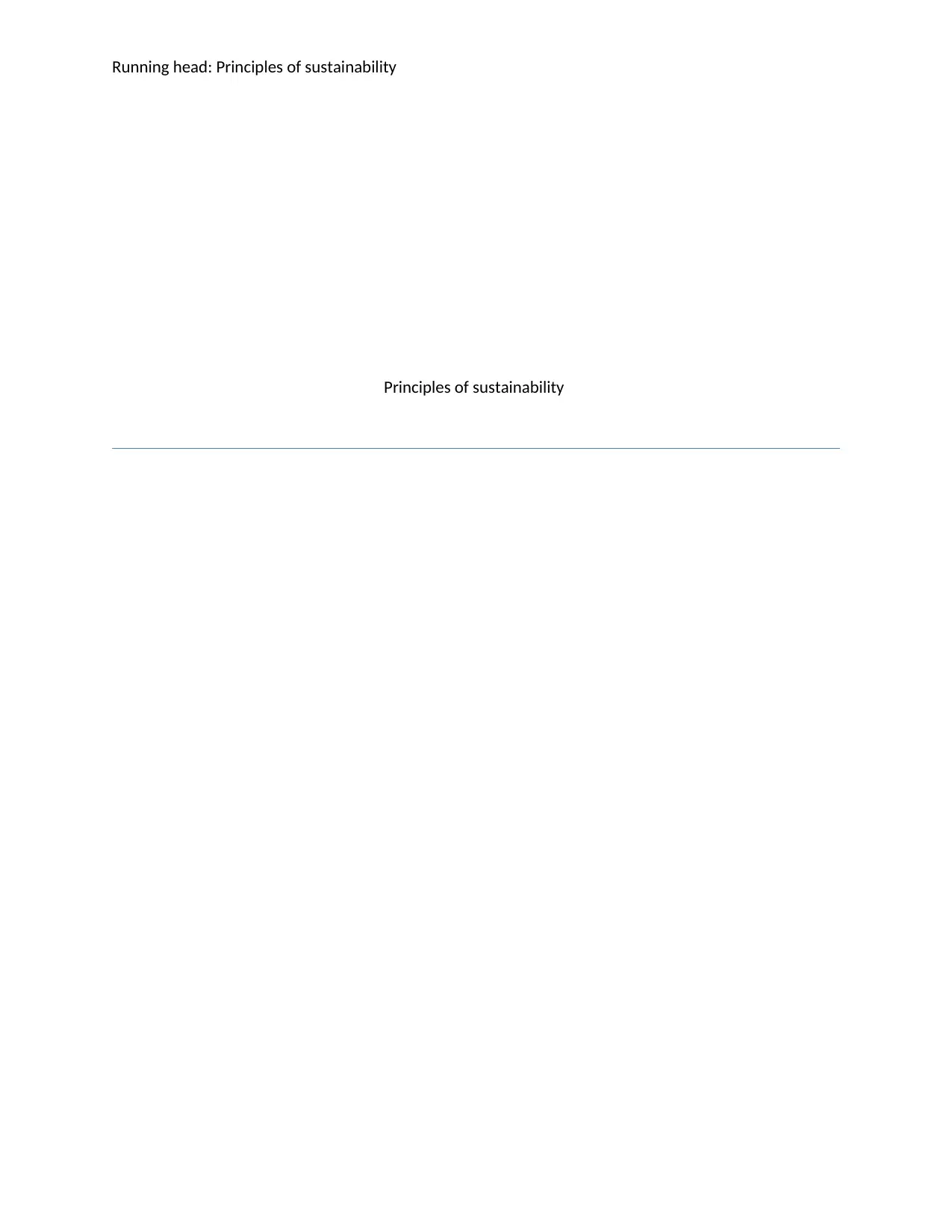
Running head: Principles of sustainability
Principles of sustainability
Principles of sustainability
Paraphrase This Document
Need a fresh take? Get an instant paraphrase of this document with our AI Paraphraser
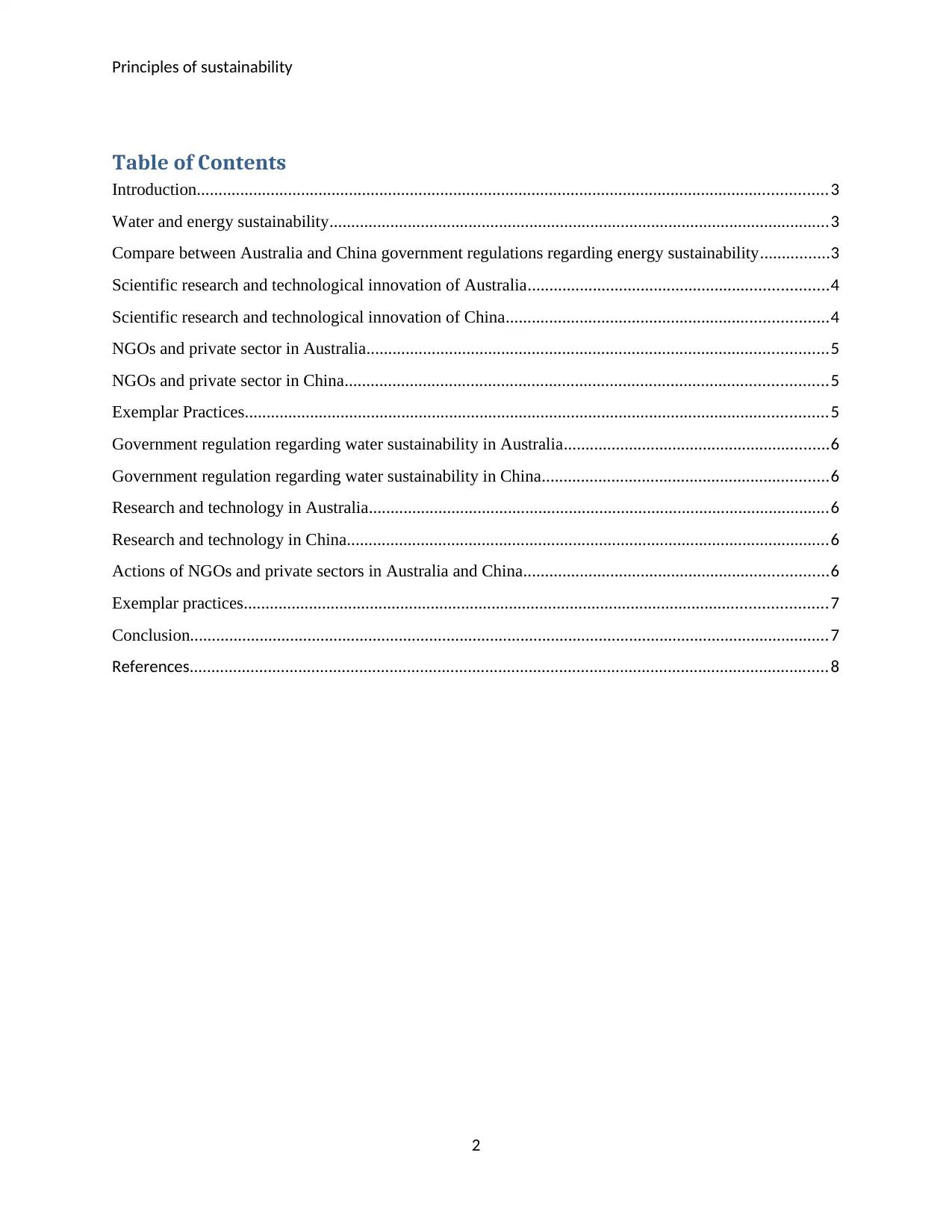
Principles of sustainability
Table of Contents
Introduction.................................................................................................................................................3
Water and energy sustainability...................................................................................................................3
Compare between Australia and China government regulations regarding energy sustainability................3
Scientific research and technological innovation of Australia.....................................................................4
Scientific research and technological innovation of China..........................................................................4
NGOs and private sector in Australia..........................................................................................................5
NGOs and private sector in China...............................................................................................................5
Exemplar Practices......................................................................................................................................5
Government regulation regarding water sustainability in Australia.............................................................6
Government regulation regarding water sustainability in China..................................................................6
Research and technology in Australia..........................................................................................................6
Research and technology in China...............................................................................................................6
Actions of NGOs and private sectors in Australia and China......................................................................6
Exemplar practices......................................................................................................................................7
Conclusion...................................................................................................................................................7
References...................................................................................................................................................8
2
Table of Contents
Introduction.................................................................................................................................................3
Water and energy sustainability...................................................................................................................3
Compare between Australia and China government regulations regarding energy sustainability................3
Scientific research and technological innovation of Australia.....................................................................4
Scientific research and technological innovation of China..........................................................................4
NGOs and private sector in Australia..........................................................................................................5
NGOs and private sector in China...............................................................................................................5
Exemplar Practices......................................................................................................................................5
Government regulation regarding water sustainability in Australia.............................................................6
Government regulation regarding water sustainability in China..................................................................6
Research and technology in Australia..........................................................................................................6
Research and technology in China...............................................................................................................6
Actions of NGOs and private sectors in Australia and China......................................................................6
Exemplar practices......................................................................................................................................7
Conclusion...................................................................................................................................................7
References...................................................................................................................................................8
2
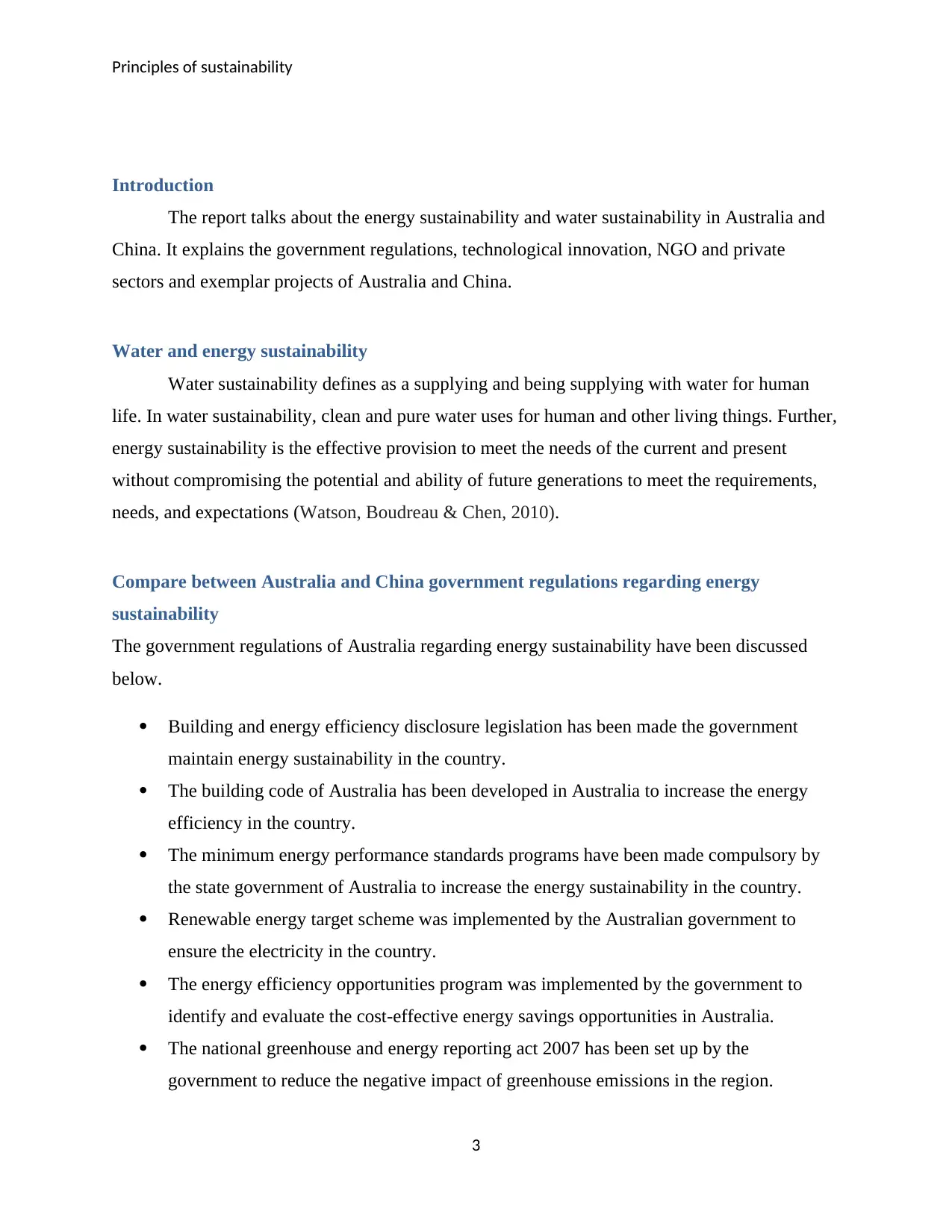
Principles of sustainability
Introduction
The report talks about the energy sustainability and water sustainability in Australia and
China. It explains the government regulations, technological innovation, NGO and private
sectors and exemplar projects of Australia and China.
Water and energy sustainability
Water sustainability defines as a supplying and being supplying with water for human
life. In water sustainability, clean and pure water uses for human and other living things. Further,
energy sustainability is the effective provision to meet the needs of the current and present
without compromising the potential and ability of future generations to meet the requirements,
needs, and expectations (Watson, Boudreau & Chen, 2010).
Compare between Australia and China government regulations regarding energy
sustainability
The government regulations of Australia regarding energy sustainability have been discussed
below.
Building and energy efficiency disclosure legislation has been made the government
maintain energy sustainability in the country.
The building code of Australia has been developed in Australia to increase the energy
efficiency in the country.
The minimum energy performance standards programs have been made compulsory by
the state government of Australia to increase the energy sustainability in the country.
Renewable energy target scheme was implemented by the Australian government to
ensure the electricity in the country.
The energy efficiency opportunities program was implemented by the government to
identify and evaluate the cost-effective energy savings opportunities in Australia.
The national greenhouse and energy reporting act 2007 has been set up by the
government to reduce the negative impact of greenhouse emissions in the region.
3
Introduction
The report talks about the energy sustainability and water sustainability in Australia and
China. It explains the government regulations, technological innovation, NGO and private
sectors and exemplar projects of Australia and China.
Water and energy sustainability
Water sustainability defines as a supplying and being supplying with water for human
life. In water sustainability, clean and pure water uses for human and other living things. Further,
energy sustainability is the effective provision to meet the needs of the current and present
without compromising the potential and ability of future generations to meet the requirements,
needs, and expectations (Watson, Boudreau & Chen, 2010).
Compare between Australia and China government regulations regarding energy
sustainability
The government regulations of Australia regarding energy sustainability have been discussed
below.
Building and energy efficiency disclosure legislation has been made the government
maintain energy sustainability in the country.
The building code of Australia has been developed in Australia to increase the energy
efficiency in the country.
The minimum energy performance standards programs have been made compulsory by
the state government of Australia to increase the energy sustainability in the country.
Renewable energy target scheme was implemented by the Australian government to
ensure the electricity in the country.
The energy efficiency opportunities program was implemented by the government to
identify and evaluate the cost-effective energy savings opportunities in Australia.
The national greenhouse and energy reporting act 2007 has been set up by the
government to reduce the negative impact of greenhouse emissions in the region.
3
⊘ This is a preview!⊘
Do you want full access?
Subscribe today to unlock all pages.

Trusted by 1+ million students worldwide
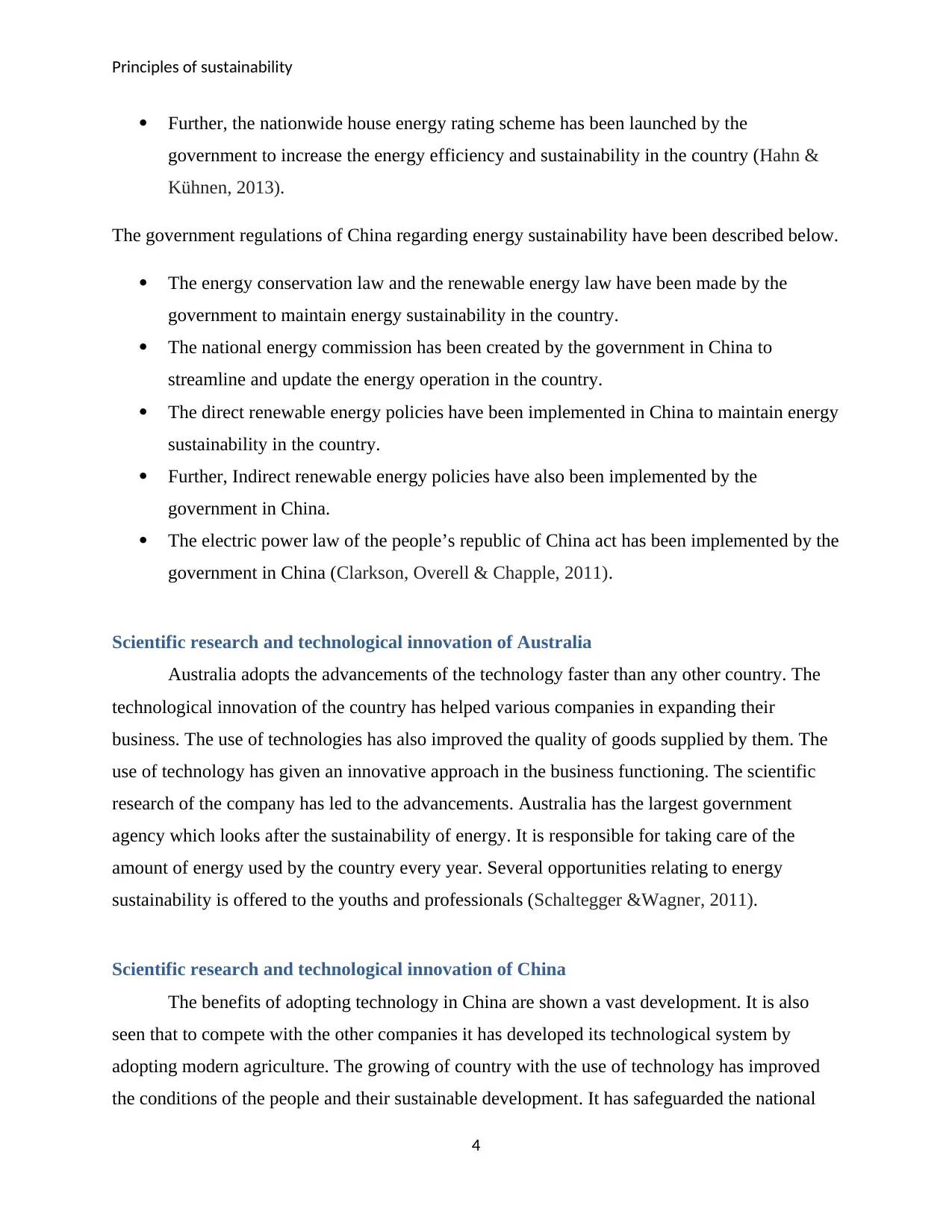
Principles of sustainability
Further, the nationwide house energy rating scheme has been launched by the
government to increase the energy efficiency and sustainability in the country (Hahn &
Kühnen, 2013).
The government regulations of China regarding energy sustainability have been described below.
The energy conservation law and the renewable energy law have been made by the
government to maintain energy sustainability in the country.
The national energy commission has been created by the government in China to
streamline and update the energy operation in the country.
The direct renewable energy policies have been implemented in China to maintain energy
sustainability in the country.
Further, Indirect renewable energy policies have also been implemented by the
government in China.
The electric power law of the people’s republic of China act has been implemented by the
government in China (Clarkson, Overell & Chapple, 2011).
Scientific research and technological innovation of Australia
Australia adopts the advancements of the technology faster than any other country. The
technological innovation of the country has helped various companies in expanding their
business. The use of technologies has also improved the quality of goods supplied by them. The
use of technology has given an innovative approach in the business functioning. The scientific
research of the company has led to the advancements. Australia has the largest government
agency which looks after the sustainability of energy. It is responsible for taking care of the
amount of energy used by the country every year. Several opportunities relating to energy
sustainability is offered to the youths and professionals (Schaltegger &Wagner, 2011).
Scientific research and technological innovation of China
The benefits of adopting technology in China are shown a vast development. It is also
seen that to compete with the other companies it has developed its technological system by
adopting modern agriculture. The growing of country with the use of technology has improved
the conditions of the people and their sustainable development. It has safeguarded the national
4
Further, the nationwide house energy rating scheme has been launched by the
government to increase the energy efficiency and sustainability in the country (Hahn &
Kühnen, 2013).
The government regulations of China regarding energy sustainability have been described below.
The energy conservation law and the renewable energy law have been made by the
government to maintain energy sustainability in the country.
The national energy commission has been created by the government in China to
streamline and update the energy operation in the country.
The direct renewable energy policies have been implemented in China to maintain energy
sustainability in the country.
Further, Indirect renewable energy policies have also been implemented by the
government in China.
The electric power law of the people’s republic of China act has been implemented by the
government in China (Clarkson, Overell & Chapple, 2011).
Scientific research and technological innovation of Australia
Australia adopts the advancements of the technology faster than any other country. The
technological innovation of the country has helped various companies in expanding their
business. The use of technologies has also improved the quality of goods supplied by them. The
use of technology has given an innovative approach in the business functioning. The scientific
research of the company has led to the advancements. Australia has the largest government
agency which looks after the sustainability of energy. It is responsible for taking care of the
amount of energy used by the country every year. Several opportunities relating to energy
sustainability is offered to the youths and professionals (Schaltegger &Wagner, 2011).
Scientific research and technological innovation of China
The benefits of adopting technology in China are shown a vast development. It is also
seen that to compete with the other companies it has developed its technological system by
adopting modern agriculture. The growing of country with the use of technology has improved
the conditions of the people and their sustainable development. It has safeguarded the national
4
Paraphrase This Document
Need a fresh take? Get an instant paraphrase of this document with our AI Paraphraser
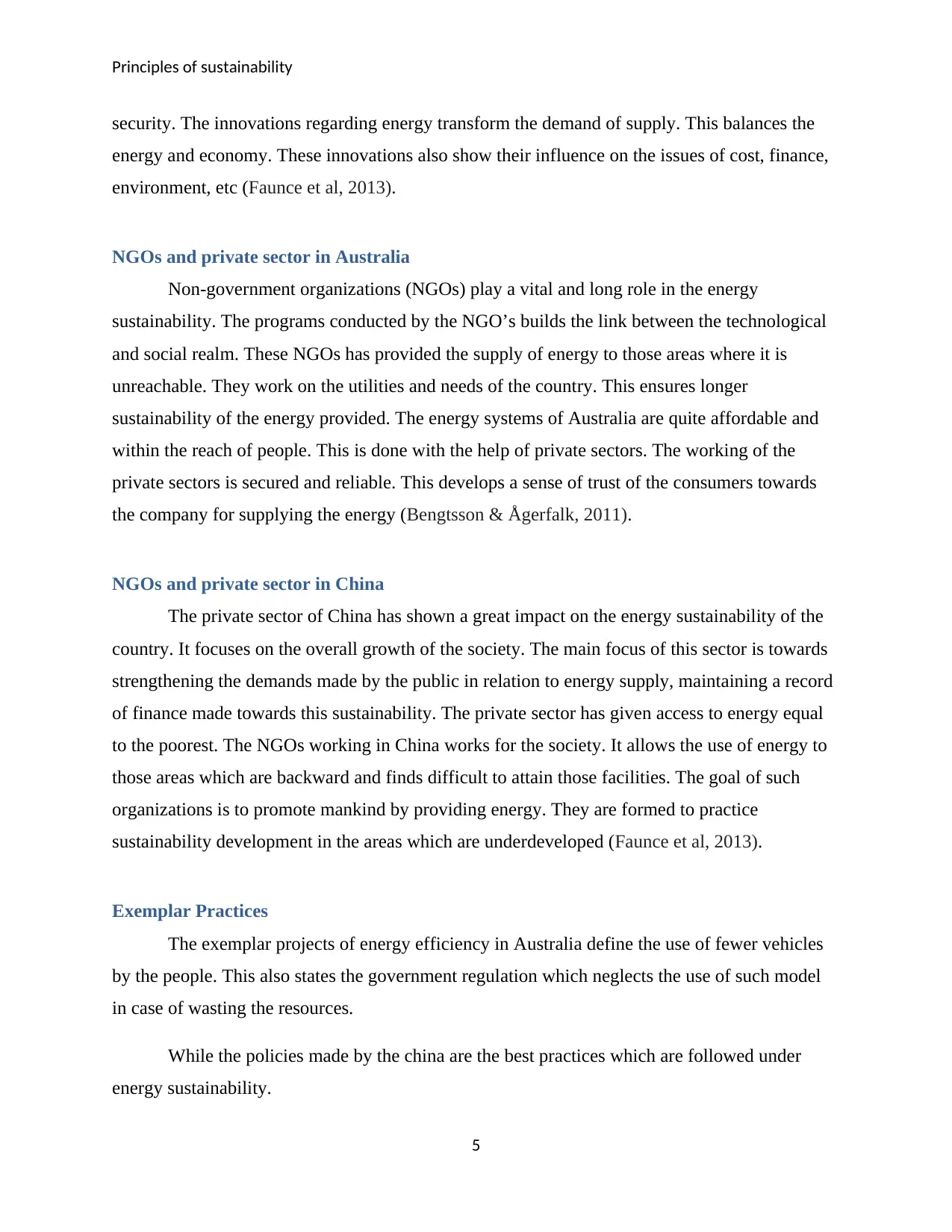
Principles of sustainability
security. The innovations regarding energy transform the demand of supply. This balances the
energy and economy. These innovations also show their influence on the issues of cost, finance,
environment, etc (Faunce et al, 2013).
NGOs and private sector in Australia
Non-government organizations (NGOs) play a vital and long role in the energy
sustainability. The programs conducted by the NGO’s builds the link between the technological
and social realm. These NGOs has provided the supply of energy to those areas where it is
unreachable. They work on the utilities and needs of the country. This ensures longer
sustainability of the energy provided. The energy systems of Australia are quite affordable and
within the reach of people. This is done with the help of private sectors. The working of the
private sectors is secured and reliable. This develops a sense of trust of the consumers towards
the company for supplying the energy (Bengtsson & Ågerfalk, 2011).
NGOs and private sector in China
The private sector of China has shown a great impact on the energy sustainability of the
country. It focuses on the overall growth of the society. The main focus of this sector is towards
strengthening the demands made by the public in relation to energy supply, maintaining a record
of finance made towards this sustainability. The private sector has given access to energy equal
to the poorest. The NGOs working in China works for the society. It allows the use of energy to
those areas which are backward and finds difficult to attain those facilities. The goal of such
organizations is to promote mankind by providing energy. They are formed to practice
sustainability development in the areas which are underdeveloped (Faunce et al, 2013).
Exemplar Practices
The exemplar projects of energy efficiency in Australia define the use of fewer vehicles
by the people. This also states the government regulation which neglects the use of such model
in case of wasting the resources.
While the policies made by the china are the best practices which are followed under
energy sustainability.
5
security. The innovations regarding energy transform the demand of supply. This balances the
energy and economy. These innovations also show their influence on the issues of cost, finance,
environment, etc (Faunce et al, 2013).
NGOs and private sector in Australia
Non-government organizations (NGOs) play a vital and long role in the energy
sustainability. The programs conducted by the NGO’s builds the link between the technological
and social realm. These NGOs has provided the supply of energy to those areas where it is
unreachable. They work on the utilities and needs of the country. This ensures longer
sustainability of the energy provided. The energy systems of Australia are quite affordable and
within the reach of people. This is done with the help of private sectors. The working of the
private sectors is secured and reliable. This develops a sense of trust of the consumers towards
the company for supplying the energy (Bengtsson & Ågerfalk, 2011).
NGOs and private sector in China
The private sector of China has shown a great impact on the energy sustainability of the
country. It focuses on the overall growth of the society. The main focus of this sector is towards
strengthening the demands made by the public in relation to energy supply, maintaining a record
of finance made towards this sustainability. The private sector has given access to energy equal
to the poorest. The NGOs working in China works for the society. It allows the use of energy to
those areas which are backward and finds difficult to attain those facilities. The goal of such
organizations is to promote mankind by providing energy. They are formed to practice
sustainability development in the areas which are underdeveloped (Faunce et al, 2013).
Exemplar Practices
The exemplar projects of energy efficiency in Australia define the use of fewer vehicles
by the people. This also states the government regulation which neglects the use of such model
in case of wasting the resources.
While the policies made by the china are the best practices which are followed under
energy sustainability.
5
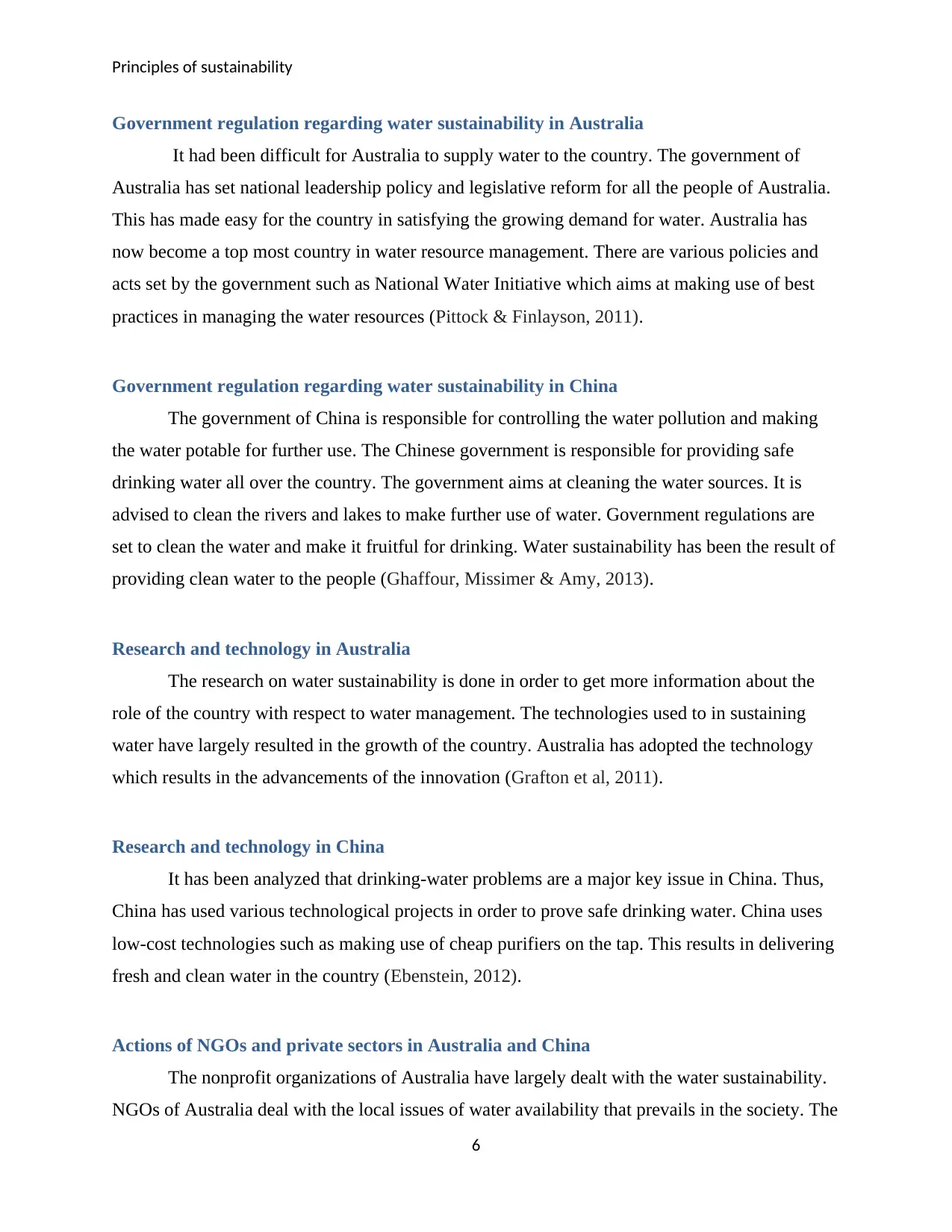
Principles of sustainability
Government regulation regarding water sustainability in Australia
It had been difficult for Australia to supply water to the country. The government of
Australia has set national leadership policy and legislative reform for all the people of Australia.
This has made easy for the country in satisfying the growing demand for water. Australia has
now become a top most country in water resource management. There are various policies and
acts set by the government such as National Water Initiative which aims at making use of best
practices in managing the water resources (Pittock & Finlayson, 2011).
Government regulation regarding water sustainability in China
The government of China is responsible for controlling the water pollution and making
the water potable for further use. The Chinese government is responsible for providing safe
drinking water all over the country. The government aims at cleaning the water sources. It is
advised to clean the rivers and lakes to make further use of water. Government regulations are
set to clean the water and make it fruitful for drinking. Water sustainability has been the result of
providing clean water to the people (Ghaffour, Missimer & Amy, 2013).
Research and technology in Australia
The research on water sustainability is done in order to get more information about the
role of the country with respect to water management. The technologies used to in sustaining
water have largely resulted in the growth of the country. Australia has adopted the technology
which results in the advancements of the innovation (Grafton et al, 2011).
Research and technology in China
It has been analyzed that drinking-water problems are a major key issue in China. Thus,
China has used various technological projects in order to prove safe drinking water. China uses
low-cost technologies such as making use of cheap purifiers on the tap. This results in delivering
fresh and clean water in the country (Ebenstein, 2012).
Actions of NGOs and private sectors in Australia and China
The nonprofit organizations of Australia have largely dealt with the water sustainability.
NGOs of Australia deal with the local issues of water availability that prevails in the society. The
6
Government regulation regarding water sustainability in Australia
It had been difficult for Australia to supply water to the country. The government of
Australia has set national leadership policy and legislative reform for all the people of Australia.
This has made easy for the country in satisfying the growing demand for water. Australia has
now become a top most country in water resource management. There are various policies and
acts set by the government such as National Water Initiative which aims at making use of best
practices in managing the water resources (Pittock & Finlayson, 2011).
Government regulation regarding water sustainability in China
The government of China is responsible for controlling the water pollution and making
the water potable for further use. The Chinese government is responsible for providing safe
drinking water all over the country. The government aims at cleaning the water sources. It is
advised to clean the rivers and lakes to make further use of water. Government regulations are
set to clean the water and make it fruitful for drinking. Water sustainability has been the result of
providing clean water to the people (Ghaffour, Missimer & Amy, 2013).
Research and technology in Australia
The research on water sustainability is done in order to get more information about the
role of the country with respect to water management. The technologies used to in sustaining
water have largely resulted in the growth of the country. Australia has adopted the technology
which results in the advancements of the innovation (Grafton et al, 2011).
Research and technology in China
It has been analyzed that drinking-water problems are a major key issue in China. Thus,
China has used various technological projects in order to prove safe drinking water. China uses
low-cost technologies such as making use of cheap purifiers on the tap. This results in delivering
fresh and clean water in the country (Ebenstein, 2012).
Actions of NGOs and private sectors in Australia and China
The nonprofit organizations of Australia have largely dealt with the water sustainability.
NGOs of Australia deal with the local issues of water availability that prevails in the society. The
6
⊘ This is a preview!⊘
Do you want full access?
Subscribe today to unlock all pages.

Trusted by 1+ million students worldwide
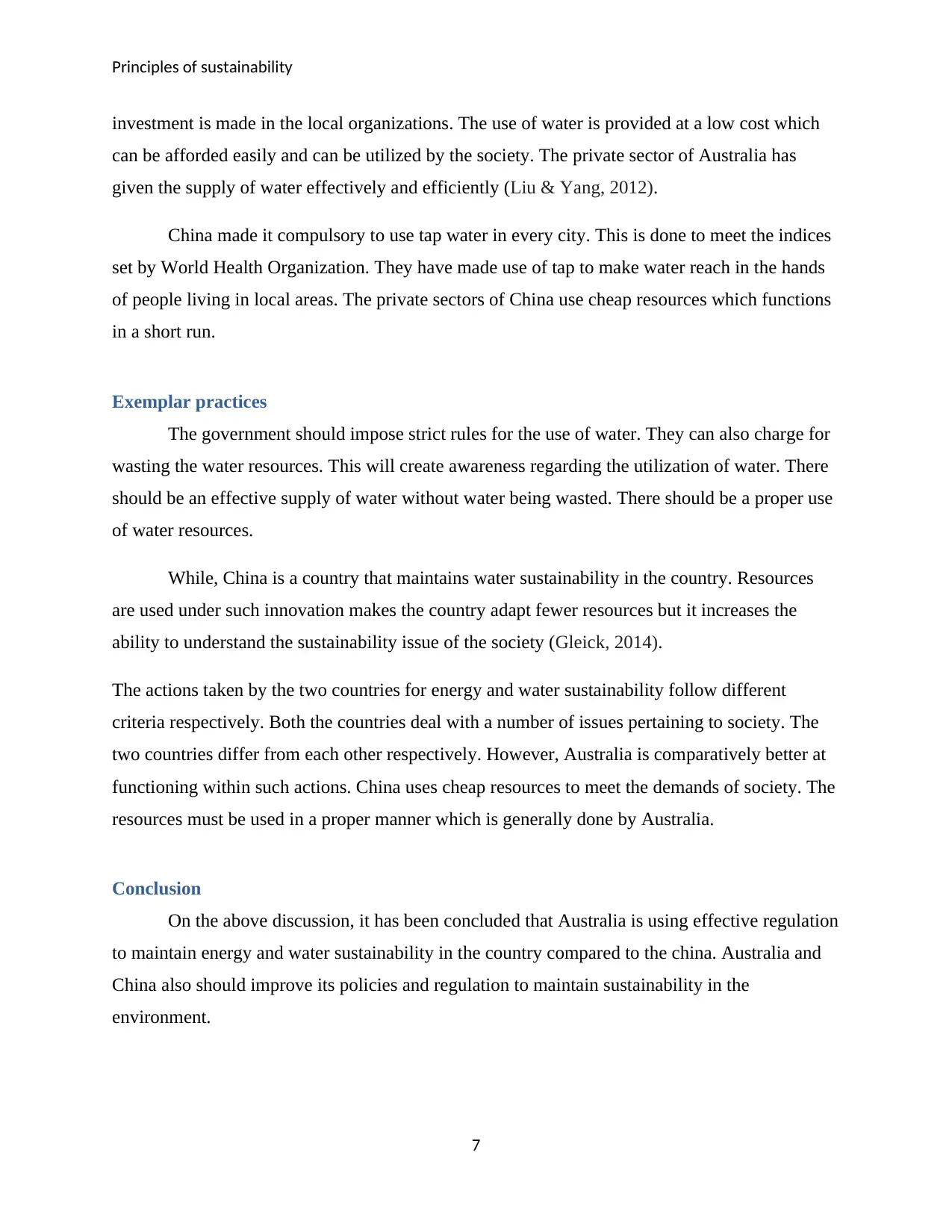
Principles of sustainability
investment is made in the local organizations. The use of water is provided at a low cost which
can be afforded easily and can be utilized by the society. The private sector of Australia has
given the supply of water effectively and efficiently (Liu & Yang, 2012).
China made it compulsory to use tap water in every city. This is done to meet the indices
set by World Health Organization. They have made use of tap to make water reach in the hands
of people living in local areas. The private sectors of China use cheap resources which functions
in a short run.
Exemplar practices
The government should impose strict rules for the use of water. They can also charge for
wasting the water resources. This will create awareness regarding the utilization of water. There
should be an effective supply of water without water being wasted. There should be a proper use
of water resources.
While, China is a country that maintains water sustainability in the country. Resources
are used under such innovation makes the country adapt fewer resources but it increases the
ability to understand the sustainability issue of the society (Gleick, 2014).
The actions taken by the two countries for energy and water sustainability follow different
criteria respectively. Both the countries deal with a number of issues pertaining to society. The
two countries differ from each other respectively. However, Australia is comparatively better at
functioning within such actions. China uses cheap resources to meet the demands of society. The
resources must be used in a proper manner which is generally done by Australia.
Conclusion
On the above discussion, it has been concluded that Australia is using effective regulation
to maintain energy and water sustainability in the country compared to the china. Australia and
China also should improve its policies and regulation to maintain sustainability in the
environment.
7
investment is made in the local organizations. The use of water is provided at a low cost which
can be afforded easily and can be utilized by the society. The private sector of Australia has
given the supply of water effectively and efficiently (Liu & Yang, 2012).
China made it compulsory to use tap water in every city. This is done to meet the indices
set by World Health Organization. They have made use of tap to make water reach in the hands
of people living in local areas. The private sectors of China use cheap resources which functions
in a short run.
Exemplar practices
The government should impose strict rules for the use of water. They can also charge for
wasting the water resources. This will create awareness regarding the utilization of water. There
should be an effective supply of water without water being wasted. There should be a proper use
of water resources.
While, China is a country that maintains water sustainability in the country. Resources
are used under such innovation makes the country adapt fewer resources but it increases the
ability to understand the sustainability issue of the society (Gleick, 2014).
The actions taken by the two countries for energy and water sustainability follow different
criteria respectively. Both the countries deal with a number of issues pertaining to society. The
two countries differ from each other respectively. However, Australia is comparatively better at
functioning within such actions. China uses cheap resources to meet the demands of society. The
resources must be used in a proper manner which is generally done by Australia.
Conclusion
On the above discussion, it has been concluded that Australia is using effective regulation
to maintain energy and water sustainability in the country compared to the china. Australia and
China also should improve its policies and regulation to maintain sustainability in the
environment.
7
Paraphrase This Document
Need a fresh take? Get an instant paraphrase of this document with our AI Paraphraser
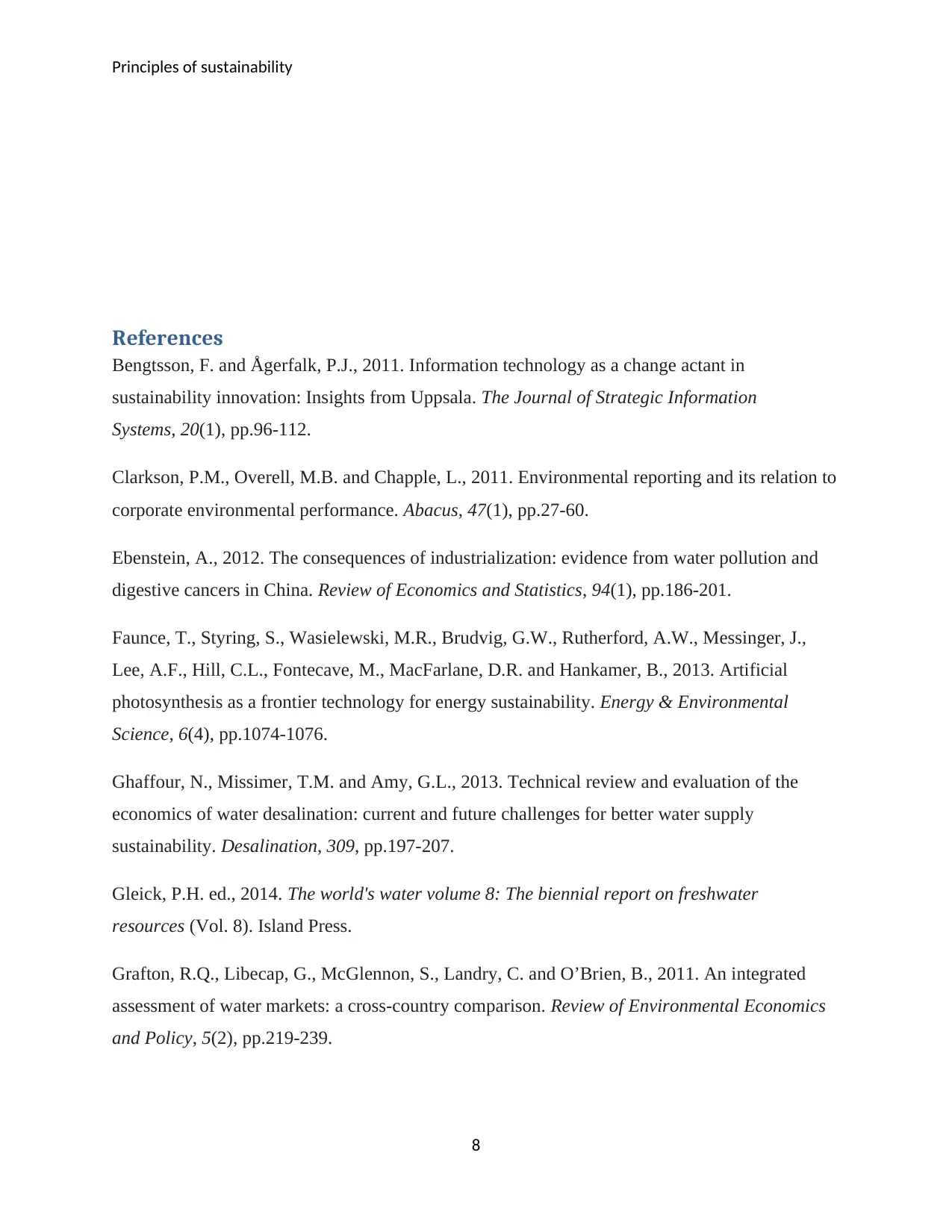
Principles of sustainability
References
Bengtsson, F. and Ågerfalk, P.J., 2011. Information technology as a change actant in
sustainability innovation: Insights from Uppsala. The Journal of Strategic Information
Systems, 20(1), pp.96-112.
Clarkson, P.M., Overell, M.B. and Chapple, L., 2011. Environmental reporting and its relation to
corporate environmental performance. Abacus, 47(1), pp.27-60.
Ebenstein, A., 2012. The consequences of industrialization: evidence from water pollution and
digestive cancers in China. Review of Economics and Statistics, 94(1), pp.186-201.
Faunce, T., Styring, S., Wasielewski, M.R., Brudvig, G.W., Rutherford, A.W., Messinger, J.,
Lee, A.F., Hill, C.L., Fontecave, M., MacFarlane, D.R. and Hankamer, B., 2013. Artificial
photosynthesis as a frontier technology for energy sustainability. Energy & Environmental
Science, 6(4), pp.1074-1076.
Ghaffour, N., Missimer, T.M. and Amy, G.L., 2013. Technical review and evaluation of the
economics of water desalination: current and future challenges for better water supply
sustainability. Desalination, 309, pp.197-207.
Gleick, P.H. ed., 2014. The world's water volume 8: The biennial report on freshwater
resources (Vol. 8). Island Press.
Grafton, R.Q., Libecap, G., McGlennon, S., Landry, C. and O’Brien, B., 2011. An integrated
assessment of water markets: a cross-country comparison. Review of Environmental Economics
and Policy, 5(2), pp.219-239.
8
References
Bengtsson, F. and Ågerfalk, P.J., 2011. Information technology as a change actant in
sustainability innovation: Insights from Uppsala. The Journal of Strategic Information
Systems, 20(1), pp.96-112.
Clarkson, P.M., Overell, M.B. and Chapple, L., 2011. Environmental reporting and its relation to
corporate environmental performance. Abacus, 47(1), pp.27-60.
Ebenstein, A., 2012. The consequences of industrialization: evidence from water pollution and
digestive cancers in China. Review of Economics and Statistics, 94(1), pp.186-201.
Faunce, T., Styring, S., Wasielewski, M.R., Brudvig, G.W., Rutherford, A.W., Messinger, J.,
Lee, A.F., Hill, C.L., Fontecave, M., MacFarlane, D.R. and Hankamer, B., 2013. Artificial
photosynthesis as a frontier technology for energy sustainability. Energy & Environmental
Science, 6(4), pp.1074-1076.
Ghaffour, N., Missimer, T.M. and Amy, G.L., 2013. Technical review and evaluation of the
economics of water desalination: current and future challenges for better water supply
sustainability. Desalination, 309, pp.197-207.
Gleick, P.H. ed., 2014. The world's water volume 8: The biennial report on freshwater
resources (Vol. 8). Island Press.
Grafton, R.Q., Libecap, G., McGlennon, S., Landry, C. and O’Brien, B., 2011. An integrated
assessment of water markets: a cross-country comparison. Review of Environmental Economics
and Policy, 5(2), pp.219-239.
8
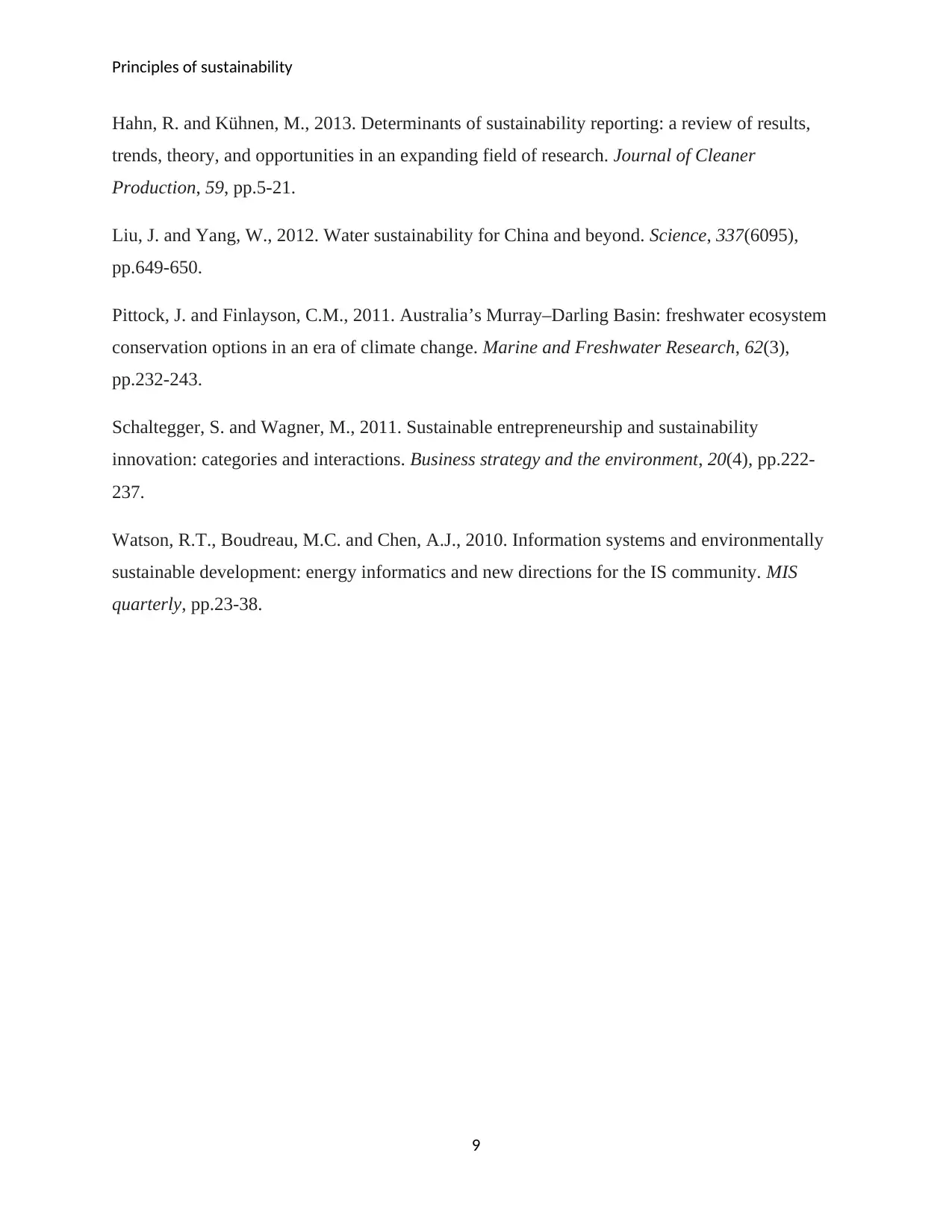
Principles of sustainability
Hahn, R. and Kühnen, M., 2013. Determinants of sustainability reporting: a review of results,
trends, theory, and opportunities in an expanding field of research. Journal of Cleaner
Production, 59, pp.5-21.
Liu, J. and Yang, W., 2012. Water sustainability for China and beyond. Science, 337(6095),
pp.649-650.
Pittock, J. and Finlayson, C.M., 2011. Australia’s Murray–Darling Basin: freshwater ecosystem
conservation options in an era of climate change. Marine and Freshwater Research, 62(3),
pp.232-243.
Schaltegger, S. and Wagner, M., 2011. Sustainable entrepreneurship and sustainability
innovation: categories and interactions. Business strategy and the environment, 20(4), pp.222-
237.
Watson, R.T., Boudreau, M.C. and Chen, A.J., 2010. Information systems and environmentally
sustainable development: energy informatics and new directions for the IS community. MIS
quarterly, pp.23-38.
9
Hahn, R. and Kühnen, M., 2013. Determinants of sustainability reporting: a review of results,
trends, theory, and opportunities in an expanding field of research. Journal of Cleaner
Production, 59, pp.5-21.
Liu, J. and Yang, W., 2012. Water sustainability for China and beyond. Science, 337(6095),
pp.649-650.
Pittock, J. and Finlayson, C.M., 2011. Australia’s Murray–Darling Basin: freshwater ecosystem
conservation options in an era of climate change. Marine and Freshwater Research, 62(3),
pp.232-243.
Schaltegger, S. and Wagner, M., 2011. Sustainable entrepreneurship and sustainability
innovation: categories and interactions. Business strategy and the environment, 20(4), pp.222-
237.
Watson, R.T., Boudreau, M.C. and Chen, A.J., 2010. Information systems and environmentally
sustainable development: energy informatics and new directions for the IS community. MIS
quarterly, pp.23-38.
9
⊘ This is a preview!⊘
Do you want full access?
Subscribe today to unlock all pages.

Trusted by 1+ million students worldwide
1 out of 9
Related Documents
Your All-in-One AI-Powered Toolkit for Academic Success.
+13062052269
info@desklib.com
Available 24*7 on WhatsApp / Email
![[object Object]](/_next/static/media/star-bottom.7253800d.svg)
Unlock your academic potential
Copyright © 2020–2025 A2Z Services. All Rights Reserved. Developed and managed by ZUCOL.





